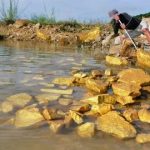Gold mining in Australia has been a significant industry for over a century, with the country being one of the leading producers of gold in the world. The prospect of gold mining in Australia continues to be a topic of great interest, as new technologies and exploration methods have the potential to uncover untapped resources. In this article, we will explore the current state of gold mining in Australia and the potential for future growth in the industry.
Exploring the prospects of gold mining in Australia involves analyzing the country’s abundant mineral reserves, favorable mining regulations, and established mining industry infrastructure. Australia is one of the world’s leading gold producers, with significant untapped potential for further exploration and development. Factors such as technological advancements and increasing global demand for precious metals also contribute to the promising prospects for gold mining in the country. Additionally, the presence of skilled labor and expertise in mining operations further enhances the potential for successful gold mining ventures in Australia.
The History of Gold Mining in Australia
See also: gold mining and processing

The history of gold mining in Australia dates back to the early 19th century, shortly after New South Wales was established as a penal colony. The first gold discovery in the country was made in 1851 near Bathurst, sparking a gold rush that led to a rapid influx of immigrants seeking their fortunes.
The Victorian gold rush of the 1850s was particularly significant, as it resulted in a large population boom and a shift in the country’s economy. This period saw the establishment of famous mining towns such as Ballarat and Bendigo, where large quantities of gold were unearthed.
The discovery of gold in Western Australia in the 1890s further fueled the country’s mining industry, with significant deposits found in areas such as Kalgoorlie and Coolgardie. These discoveries played a crucial role in shaping the economic and social landscape of Australia, influencing policies and infrastructure development.
Over the years, gold mining has continued to be a significant industry in Australia, contributing to the country’s economy and shaping its history. Today, Australia is one of the leading gold-producing nations in the world, with modern mining techniques and technologies driving the industry forward.
The Impact of Gold Mining on Australia’s Environment

Gold mining in Australia has had significant impacts on the environment. One of the key environmental concerns is the use of large amounts of water in the mining process, which can lead to both water scarcity and pollution. Additionally, the excavation and disturbance of land for gold mining activities can lead to habitat destruction and loss of biodiversity. The use of toxic chemicals such as cyanide in the extraction process also poses risks to the surrounding environment and wildlife. Furthermore, the processing and smelting of gold can result in air and water pollution, impacting the local ecosystems and communities. Efforts to mitigate these impacts include improved water management, environmental rehabilitation of mined areas, and the development of more sustainable mining practices. Despite these efforts, the environmental impact of gold mining continues to be a significant concern in Australia.
The Economic Significance of Gold Mining in Australia

Gold mining has had a significant impact on the economy of Australia, contributing to its status as one of the world’s leading gold producers. The industry has created thousands of jobs, both directly and indirectly, and has stimulated economic growth in many regional areas.
In 2019-2020, Australia produced over 327 tonnes of gold, with a value of about AUD $27 billion. This made gold Australia’s third most valuable export commodity after iron ore and coal.
Gold mining has also attracted substantial investment in infrastructure, technology, and exploration, helping to create a robust mining industry that benefits the wider economy. Additionally, the royalty and tax revenues generated from gold mining have contributed to funding public services and infrastructure projects.
The industry has also helped to underpin the value of the Australian dollar, as gold exports contribute significantly to the nation’s trade balance. In times of economic uncertainty, gold has traditionally served as a safe-haven investment, making Australia’s gold mining industry a crucial component of the nation’s economic stability.
Challenges Faced by Gold Miners in Australia

Operating in remote areas: Gold mining operations in Australia often take place in remote and isolated regions, posing logistical and infrastructure challenges for miners.
Environmental impact: Gold mining can have significant environmental impacts, including habitat destruction, pollution of air and water, and the use of large amounts of water and energy.
Regulatory compliance: Gold miners in Australia must comply with strict regulations and environmental standards, which can add complexity and cost to their operations.
Labor shortage: Some areas of Australia face labor shortages, making it difficult for gold miners to find skilled workers to operate and maintain their mining equipment.
Market volatility: The price of gold can fluctuate significantly, impacting the profitability of gold mining operations. Miners must navigate this volatility and make strategic decisions to remain competitive.
The Evolution of Gold Mining Techniques in Australia
The evolution of gold mining techniques in Australia can be traced back to the 1850s during the gold rush. Initially, simple methods such as panning and cradling were used to extract gold from river beds and alluvial deposits.
As technology advanced, more efficient techniques such as hydraulic mining, dredging, and the use of explosives became common. These methods allowed for the extraction of gold from deeper deposits and larger quantities of ore.
In the late 19th and early 20th centuries, the introduction of cyanide leaching revolutionized gold processing, making it possible to recover gold from low-grade ores. This innovation significantly increased the productivity and profitability of gold mining operations in Australia.
Today, modern techniques such as open-pit mining, underground mining, and heap leaching are used to extract gold from a variety of deposits. Environmental and safety regulations have also led to the development of more sustainable and responsible mining practices.
Overall, the evolution of gold mining techniques in Australia has been marked by continuous innovation and technological advancements, leading to more efficient and environmentally friendly methods of gold extraction.
The Role of Indigenous Australians in Gold Mining
Indigenous Australians have played a significant role in the gold mining industry throughout history. Many Indigenous people worked as laborers, prospectors, and guides during the gold rush era in the 19th century. They provided valuable knowledge of the land and its resources, and their skills were crucial in the success of many mining operations.
Additionally, some Indigenous Australians owned and operated their own gold mines, contributing to the overall development of the industry. Despite facing discrimination and unequal treatment, Indigenous people made important contributions to Australia’s gold mining history and continue to be involved in the industry today. Efforts are being made to recognize and honor their contributions and to provide more opportunities for Indigenous participation in the mining sector.
The Future of Gold Mining in Australia
The future of gold mining in Australia remains promising, as the country is one of the leading gold producers in the world. With advancements in technology, such as big data analytics and automation, the industry is becoming more efficient and sustainable. Additionally, new discoveries and mining projects are continually being explored and developed, indicating a positive outlook for the gold mining sector in Australia. With the demand for gold persisting in various industries, including jewelry, electronics, and investment, the future of gold mining in Australia is expected to remain robust.
Exploring Australia’s Untapped Gold Mining Potential
Australia has a rich history of gold mining, with significant gold discoveries dating back to the 1850s. However, there is still potential for further gold exploration and mining in untapped areas of the country. The exploration of these untapped regions has the potential to uncover new gold deposits and contribute to Australia’s thriving mining industry.
One area of interest for gold exploration is the Northern Territory, where potential gold deposits have been identified but not yet fully exploited. Additionally, Western Australia, known for its prolific gold production, continues to offer opportunities for further exploration and development.
Advancements in technology and exploration techniques have made it possible to discover gold deposits that were previously inaccessible or overlooked. This has opened up new possibilities for uncovering untapped potential in Australia’s gold mining industry.
Exploring Australia’s untapped gold mining potential not only offers economic opportunities but also contributes to the country’s mineral resource development and sustainability. With the right investment and exploration efforts, Australia has the potential to further solidify its position as a leading gold producer on the global stage.
The Influence of Gold Mining on Australia’s Culture and Identity
Gold mining has played a significant role in shaping Australia’s culture and identity. The influx of prospectors during the 19th century gold rushes led to the rapid expansion of settlements and the development of infrastructure, ultimately contributing to the growth of the nation. The pursuit of gold also brought people from diverse backgrounds, creating a multicultural society reflective of Australia today.
The impact of gold mining on Indigenous communities, however, has been a subject of controversy. Many Indigenous lands were disrupted and dispossessed during the gold rush era, leading to long-term repercussions for these communities. Additionally, the environmental effects of gold mining have raised concerns about the preservation of Australia’s natural landscapes.
Despite these issues, the legacy of gold mining remains deeply ingrained in Australia’s national identity. The resilience, resourcefulness, and perseverance demonstrated by the early miners continue to be celebrated as integral aspects of the country’s character. Furthermore, gold mining has left a lasting imprint on the landscape, with historic sites and artifacts serving as reminders of the nation’s economic and social transformation.
Overall, the influence of gold mining on Australia’s culture and identity is complex, encompassing both positive and negative consequences. The industry’s profound impact on the nation’s history, economy, and societal fabric underscores its enduring significance in shaping Australia’s collective identity.
Sustainable Practices in Australia’s Gold Mining Industry
Australia’s gold mining industry has implemented various sustainable practices to minimize its environmental impact. These initiatives include reducing water consumption through the use of innovative technologies such as dry processing, implementing rehabilitation and reforestation programs to restore disturbed land, and minimizing energy consumption by using renewable energy sources.
In addition, the industry is investing in research and development to improve the efficiency of its operations and reduce carbon emissions. This includes the adoption of autonomous vehicles and electrification of mining equipment to reduce the reliance on diesel-powered machinery.
Furthermore, Australian gold mining companies are actively engaging with local communities to ensure sustainable development and minimize social impact. This includes supporting local employment and providing education and training programs for the workforce.
Overall, the Australian gold mining industry is committed to implementing sustainable practices to ensure the long-term viability of the sector while minimizing its environmental and social footprint.









